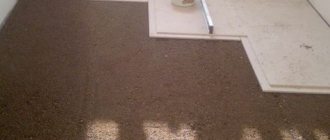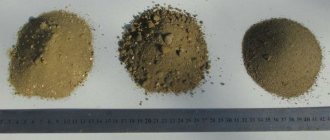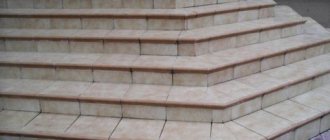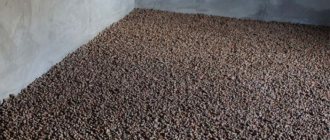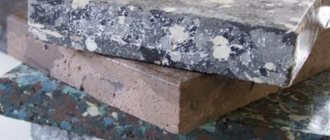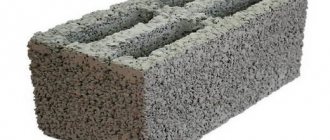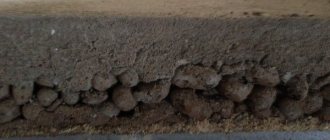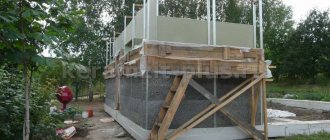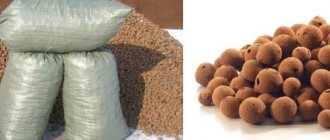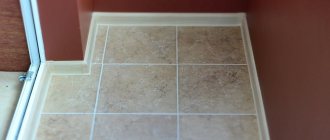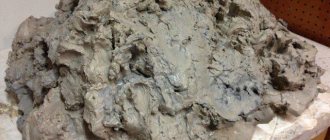Expanded clay concrete block
Materials that are varieties of concrete have not lost their popularity over the years. This is due to the properties of the products and the excellent performance of buildings built from them.
In this article we will understand what is remarkable about this type of lightweight concrete, expanded clay concrete. And how does it differ from materials with similar characteristics. Properties of expanded clay concrete: let's take a closer look at the characteristics and their indicators.
Screed with expanded clay
It's no secret that in new houses, and not only in new ones, quite often you can find various differences in height between the floors. If the differences are not large, then leveling usually comes down to using a semi-dry screed or using a self-leveling mixture. If the floor level differs more significantly, then there is a need to use a screed with expanded clay. Expanded clay should not be afraid - it is an environmentally friendly material made from clay.
Screed with expanded clay
A screed with expanded clay will raise your floor to the required height, which will allow you to bring it to the same level throughout the apartment. There are quite a lot of advantages of such a screed with expanded clay, including price, weight and excellent characteristics of this material - expanded clay concrete.
A floor screed with expanded clay is used for two purposes, firstly, it ensures leveling of the floor, and secondly, an expanded clay screed is an additional layer of thermal insulation. Sometimes expanded clay concrete screed is used to hide all communications, as well as various configurations of underfloor heating systems. There are various screeds that may differ in their composition. Floor screed with expanded clay is used quite often due to its excellent characteristics.
Related articles:
Screed with expanded clay Advantages
Expanded clay floor screed has many advantages and is most often used due to such qualities as: it is relatively light in weight, is an excellent heat insulator, and is a good sound insulator.
Also, to the advantages of expanded clay concrete screed, we can add the fact that it is an environmentally friendly and healthy building material, which explains its frequent use in individual construction. The price of expanded clay concrete screed is also very competitive, and working with it does not require special skills.
When a heated floor system is used, preference is most often given to expanded clay concrete screed, because it turns out to be very profitable. Expanded clay concrete screed is very resistant to various environments, which greatly expands its use.
Due to the density of expanded clay, the density of expanded clay concrete screed is several times less than the density
betonobeton.ru
Brands of expanded clay concrete
We said that expanded clay is used in the structure of the solution as a filler. Experienced builders are able to empirically determine the composition of expanded clay concrete for flooring, since it is almost the same as with crushed stone filler. Usually the recipe is as follows:
One bucket of cement. Four buckets of sand. Five buckets of expanded clay. One and a half buckets of ordinary water. Plasticizer. Add it according to the instructions.
It is worth clarifying one question. Expanded clay consumption can be high if its fraction is small.
Must remember!
If a lot of water is poured into the solution, then expanded clay may float, which will certainly affect the quality indicators of expanded clay concrete.
Expanded clay is a lightweight building material with a porous structure. It is formed as a result of the influence of high temperatures on low-melting clay.
Expanded clay concrete contains the same basic components as other lightweight concrete (aggregate, water and binders). In terms of composition and proportions, they are also similar to lightweight concrete. So, what is the composition of expanded clay concrete per 1 m3? Let's find out.
What is expanded clay? The benefits of expanded clay and what it really is
Expanded clay is a material that consists of baked clay granules. The production process of one batch takes no more than an hour, and as a result it is possible to obtain a porous material with high thermal insulation properties. Expanded clay is sorted into fractions and packed into bags. Depending on the need, it can also be purchased in bulk.
Advantages of expanded clay
Due to its properties, the material has become especially popular in the construction of private houses and country cottages. Its main advantages include:
- resistance to moisture, rotting and all weather conditions. Expanded clay does not lose its important qualities over time, which allows it to be used for insulating floors, attics and roofs;
- environmental Safety. Only natural raw materials are used in the production of the material. Due to the lack of chemical treatment, expanded clay does not emit harmful substances and is considered an ideal insulation material for residential premises;
- excellent thermal insulation. This property, as well as good air conductivity, prevents the formation of condensation and helps create a healthy atmosphere in the house;
- low cost. Expanded clay is much cheaper than other insulation materials on the market.
Composition and proportions of expanded clay concrete
Expanded clay concrete, which is actively used in construction, is manufactured according to the GOST 6133-99 standard. It involves a description of all technical requirements for wall stones and blocks.
To obtain high-quality products, it is necessary not only to comply with the specified proportions, but also to carry out all technological processes in the correct way. Yet composition and consistency play the most important role.
Binding components
Portland cement of at least M400 is usually used as this component. With an increase in the consumption of this component, the strength of the finished product improves.
Accordingly, when the amount of cement in the expanded clay concrete mixture is reduced, its volumetric weight decreases. This is why higher grades should be used.
To prepare a mixture of expanded clay concrete, it is necessary to use water that meets the technical requirements for hardening ordinary concrete. Its composition should not contain harmful impurities that can spoil the process of setting and hardening of the binder components.
Typically, water that is suitable for drinking is used to prepare the solution.
Fillers
Expanded clay and quartz sand can be used as filler. Expanded clay as the main component gives the final product good heat and sound insulation properties. Based on shape and appearance, this material is divided into crushed stone (irregular shape and rough surface) and gravel (round shape and melted surface).
Kinds
Products with expanded clay coating are divided into types based on the area of application:
The heat-insulating slab serves as an insulating element for buildings. They are not intended for the construction of heavy structures. Often, such products are used on top of existing walls to protect against cold penetration into the room.
Structural. They have the highest strength and can be used in the construction of load-bearing elements of buildings. Due to their light weight, financial costs for installation work are significantly reduced. Structural floors made of expanded clay concrete are resistant to frost. Structural and thermal insulation are thick panels or large blocks suitable for installing walls without the use of additional insulation work. Return to contents
Installation of slopes on flat roofs
The technology for installing flat roofs, terraces, and balconies involves creating a slight slope so that rain and melt water can flow freely into stormwater systems. We carry out the slope of cement sand screed on flat roofs using semi-dry technology.
slopes on roofs, slope
Laying with a slope the load-bearing structures themselves (corrugated sheets or concrete slabs). Mainly used on slopes from 5 to 10 degrees for single-pitched and double-pitched roofs. Screed made of lightweight concrete with the creation of the required profile. A layer of lightweight concrete of variable thickness creates the necessary slope. The configuration of slope surfaces can have a complex shape. Creating a slope when forming a thermal insulation layer. This method is used when it is necessary to minimize the load on the roof. For this, either foam glass or extruded polystyrene foam is used. A standard thermal insulation board is given a variable thickness so that when laid out on a horizontal surface, the required slope is obtained.
Application of polystyrene concrete for lightweight roofs.
Since the first method is carried out mainly during the general construction of a building, it is not advisable to consider it as a component of roofing work. The most common method of forming a slope on flat roofs is a screed made of expanded clay concrete. In essence, this is not even expanded clay concrete, but basically expanded clay with a small amount of cement and water, which are necessary as a minimum binder when forming this layer. The main advantage of this method is high manufacturability and low cost. Modern technologies offer new effective solutions. One such solution is the use of polystyrene concrete. Although in our country it was developed about 25 years ago, at present, it has received a rebirth. Polystyrene concrete refers to lightweight mortar concrete, the main filler of which is polystyrene granules, “polytherm” usually have a granule size of 3 to 5 mm. The surface of the granules is processed to ensure their uniform distribution throughout the thickness of the material. The combination of heat-insulating material (polystyrene) and concrete creates an optimal combination of load-bearing properties, thermal insulation, sound insulation and fire protection.
Having almost the same cost as expanded clay concrete, polystyrene concrete surpasses it in such indicators as density, thermal conductivity, and manufacturability.
The main comparative characteristics are given below: density of polystyrene concrete and expanded clay concrete, water absorption and thermal conductivity coefficient
| Material | Density (kg/m3) | Coefficient Thermal conductivity, W/(m*S) | Water absorption % |
| Expanded clay concrete | 500-850 | 0,38 | 10 |
| Polystyrene concrete | 150-800 | 0,6-0,18 | 6 |
Expanded clay concrete Density (kg/m3): from 500 to 850 Coefficient. Thermal conductivity, W/(m*C): 0.38 Water absorption, %: 10 Polystyrene concrete Density (kg/m3): 150-550 Coefficient. Thermal conductivity, W/(m*C): 0.6-0.18 Water absorption, %: 6
It is less labor-intensive when preparing the solution directly on the construction site. Equipment for preparing and supplying solutions wears out significantly less, unlike expanded clay, which acts as an abrasive. The surface obtained after pouring is quite smooth and does not require the creation of a leveling screed. Rubbing with a solution is enough.
If the roof area is large, the reduction in such costs can be significant. The last method of creating a slope is the most labor-intensive and expensive. It is used in exceptional cases when the use of a concrete screed, for one reason or another, is not possible.
The most suitable material for this is foam glass. With this installation, the heat-insulating layer: Forms a monolith in strength not inferior to concrete while remaining lightweight. The average density of foam glass is 170 kg/m3. Performs the function of a vapor barrier, preventing moisture from condensing on the underside of the waterproofing layer. Serves as a root protective barrier on “green” roofs. Among other things, it has stable characteristics over time. There is virtually no aging of the material.
expresspol.ru
Advantages
Expanded clay concrete flooring has the following advantages:
The relatively low cost of expanded clay concrete products, which is especially important when purchasing the material in bulk. The low price allows you to save your budget, but will not affect the quality of work. The material is moisture resistant for many years of operation. The resistance to moisture of concrete with expanded clay filler is higher than that of conventional concrete. Due to its structure, which is not subject to destruction and cracking, the expanded clay concrete base is able to hold various fasteners: self-tapping screws, screws, etc. Heat resistance. Walls made of expanded clay concrete are able to retain heat and thereby reduce the cost of installing a layer of thermal insulation and heating devices. The ability to make expanded clay concrete blocks with your own hands. The lightness of reinforced concrete platforms allows you to install the structure yourself, without the use of lifting mechanisms. However, you cannot do without lifting equipment if elements with large dimensions are selected. Wide range of application of expanded clay concrete slab. They are used both in low-rise buildings and in buildings with a large number of floors. Expanded clay concrete floors have a vapor barrier, which reduces the penetration of steam and thereby protects the building from the appearance and absorption of condensation. The material is environmentally friendly. Speed of installation of expanded clay concrete blocks. Return to contents
Methods for creating screeds from expanded clay concrete
There are two methods of pouring a concrete screed using expanded clay concrete.
Wet screed
For wet screed in a residential area, you need to mix the components in the following proportions:
- 1 share PC;
- 3 shares of sand;
- 4 shares of filler (expanded clay).
Based on this, we get approximately 30 kg of sand cement per 25 kg of expanded clay.
If the screed is performed for industrial or public use, then for 1 m2 of area you will need:
- 50 kg of expanded clay;
- 60 kg of sand concrete;
- 45 kg of sand;
- 15 kg of cement.
Thus, you will receive a reliable and durable screed 5 cm thick.
To prepare the solution, follow these steps:
- Pour the expanded clay into a container (it is better to use a concrete mixer).
- Add water and wait until the aggregate granules are saturated with it.
- Constantly stirring the solution, begin to slowly add cement and sand.
- Continue stirring until the aggregate granules turn gray and the mixture becomes homogeneous.
The finished solution is poured only onto the waterproofing layer of the screed (for example, vapor-waterproofing film or durable polyethylene). After preparing this layer, you need to:
- Mark the surface.
- Install beacons and guide profiles.
- Pour expanded clay concrete onto a small area (strip) between the beacons.
- Fill the finishing screed and level it.
- Fill the next strip in the same way, and then the entire surface.
A day after completing the final pouring, the guide profiles must be removed and the resulting voids must be filled with cement mortar.
Healthy! To prevent the “fresh” screed from cracking during the hardening process, it must be covered with polyethylene and moistened with water daily.
This floor dries completely in 4 weeks, but laminate or other flooring can be laid within 2 weeks after pouring the wet screed.
Semi-dry screed
If you decide to make a semi-dry expanded clay screed, then you will need:
- Thoroughly clean the concrete base and seal all cracks and irregularities in it using concrete mortar without expanded clay.
- Place waterproofing material on the concrete surface and glue damper tape around the perimeter of the room so that it extends onto the walls by at least 15 cm.
- Place the beacons at a distance of 50 cm from each other.
- Fill in expanded clay, starting from the far corner of the room (you need to fill it in such a way that the expanded clay layer is 2 cm below the level of the beacons).
- Sprinkle the granules with cement laitance (a mixture of water and concrete, in a ratio of 2:1).
- Compact the expanded clay layer.
Advice! Already at this stage it is extremely important to form an even layer of granules. To level the expanded clay, you can use a rule - a special tool similar to a meter-wide spatula.
After a day, you can begin preparing and laying the cement-sand mixture for final leveling of the surface. Fill it gradually, sequentially filling the areas separated by beacons and carefully leveling the surface of the screed. After another 24 hours, the beacons can be removed, the holes from which are sealed with concrete and sprayed with water. Final leveling is carried out using grout and small portions of cement mixture. This screed will dry completely in 2-3 weeks.
Where are they used?
The material used is expanded clay concrete:
when constructing external walls of houses with a small number of floors; if necessary, installing soundproofing partitions; when installing buildings and structures with a natural ventilation system. In this case, blocks are used for ventilation that have through holes; to cover the walls of buildings; the application is relevant when constructing a foundation for a wooden frame; when constructing pillars for fences and decorative elements; lightweight concrete blocks, which contain expanded clay, are used in the installation of enclosing structures ;expanded clay concrete blocks can replace stones for laying borders.
Currently reading: Types and installation of reinforced concrete piles
The use of concrete structures with the addition of expanded clay is carried out based on the basic requirements for its installation. When constructing house floors, in order to reduce installation time and simplify masonry technology, expanded clay concrete floors are used instead of standard slabs. This will greatly facilitate the work of novice builders without proper experience.
When installing formwork for the foundation, monolithic expanded clay concrete floors are used, which ensure the integrity and strength of buildings and structures. A monolithic expanded clay concrete floor will significantly reduce costs compared to the costs of working with a slab.
Return to contents
